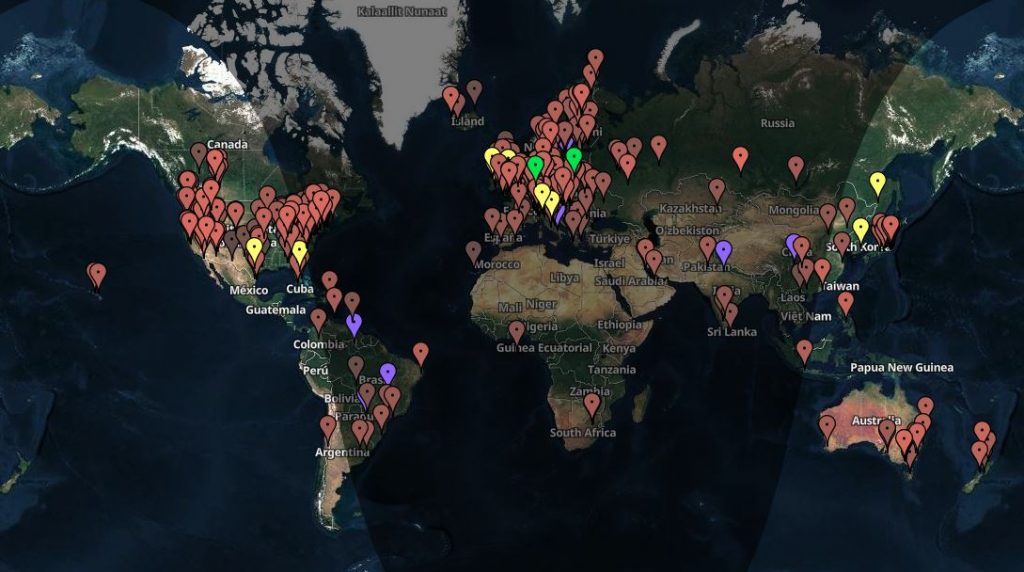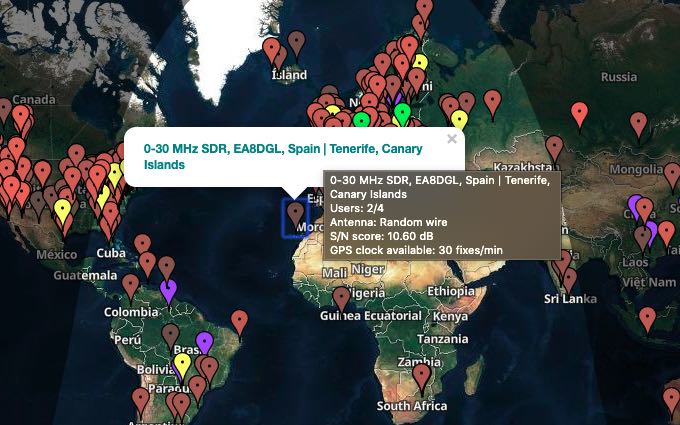Last month, we noted that the popular SDR.hu KiwiSDR portal now requires registration and an amateur radio callsign to use the site. While SDR.hu is still online, we certainly get the impression all site development has been halted. This is not the end of the world because SDR.hu is only one of several KiwiSDR portals–we linked to others in our January article.
Personally, I only used the SDR.hu map view to keep track of KiwiSDR sites and found it quite useful because I typically select sites based on geographic location.
A better KiwiSDR map portal
I’ve just learned via the KiwiSDR Twitter account that Priyom.org has updated their KiwiSDR map portal using Dyatlov maps. The results are brilliant and, in my opinion, even better than the SDR.hu’s map.
The Priyom.org map uses the full window, is uncluttered and easier to navigate.
If you click on a KiwiSDR site, you’ll see a pop-up window with basic site information. If you hover the cursor over that site info, another window will pop up with current details about the receiver, number of users, antenna, SNR, and GPS clock (see above).
This is now my favorite way to geographically surf KiwiSDR sites.
Click here to check out the new map portal.
Do you enjoy the SWLing Post?
Please consider supporting us via Patreon or our Coffee Fund!
Your support makes articles like this one possible. Thank you!




Well, there are certainly pros and cons to how much you are “fooling yourself”. The distributed network of KiwiSDRs is a fantastic achievement when you look back 10 years. Yesterday was an interesting case with the amateur dxpedition coming on from South Orkney (VP8PJ). They were totally inaudible on 14MHz here except for about 20-30 seconds! However, comparing my ‘knowledge’ with HamCAP and VOACap predictions, it should have been open to most of South America most of the day and with a 2300z opening to east coast USA. By listening to KiwiSDRs in SA I could tell they were well down on expected signals and propagation did extend slowly northwards, as expected, with me moving northwards on different receivers.
The one problem I *could* be convinced by somebody about was that some of the few USA stations who worked them were perhaps ‘alligators’, all mouth and no ears. It’s pretty easy to rustle up 2kW+ at your normal location and then use a remote receiver to copy them. My brother has a pretty effective setup ‘out west’ and barely heard them all day. However, somebody else near-ish worked them easily. His TX sounded legitimate in direction, but the rx side was a bit hard to believe. Hmmmm. Something fishy there!
I have been able to work other amateurs that I cannot hear well but they hear me, only because I can use sdr.hu!
A nice enough site for sure, but it’s not new. Been using this link for many months….
True, but they just updated their map provider so there’s no more embedded message across the map. 🙂 much less cluttered!
Actually, the links http://rx.linkfanel.net/ and http://rx.linkfanel.net/index.html show different versions of the map. Only the latter version is without the embedded message “For development purposes only”.
Thanks. Actually, I don’t see “For development purposes only” on either of those links through my browsers.
Now, I reloaded the tab with the older version of the map, the page changed to the newer version without that message. So it seems I got similar result as you this time.
Yes, ever I learn about KiwiSDR in swling.com I visit it few times a month.
But is it DX’ing… I don’t think so.
No, it is not even radio let alone shortwave DXing. Web SDR is a hybrid medium that must use both radio and telephone systems. Unlike radio, without phone lines it just doesn’t work.
Actually the KiwiSDR is a stand-alone SDR that does not have to be connected to the Internet at all, if you wish. It’s actually a fantastic SDR on its own with excellent dynamic range and a great value if you ask me.
With that said I love the Kiwi SDR network on the web. If you think about it, you’re just controlling someone’s local receiver via the web and you’re being piped the audio via the web. You’re not tuning in individual streaming radio stations over the Internet. At the local side, it’s a legacy listening experience. The Internet is just a means to control and hear audio from that remote site.
In terms of DXing, what can I say? Sure! If your goal is to log a weak station half-way across the globe from your home, then you’re only fooling yourself if you choose to log that station from a remote receiver two miles from your target and think that’s the same as using a portable from your front porch. But hey! To each their own!
Personally I love using the KiwiSDR network because it allows me to hop across the globe and experience the local and international RF scene from no matter where I am. Once, on a flight from Japan to Canada, I used the on board Wifi to globe-trot the KiwiSDR network from flight level 330! Hi hi
To me, that’s fun!
And not to ruin anyone’s pure RF experience, but many of the shows you hear [especially on private sw stations] are sent to broadcasters over wireless networks and the Internet! The majority are .WAV or .MP3 files. In fact, some sw broadcasters even feed their transmitters with live audio streams transmitted over mobile networks! Seriously!
In a sense so much of our world is built on wireless and radio. What is a smart phone? It’s a radio transceiver! Mind. Blown.
Hey, to me listening to a Kiwi SDR site from my smart phone is actually taking that original signal on an amazing wireless journey from a source, to the transmitter, to the receiver, over multiple wireless networks/site and finally to my phone. Wowza! That’s a lot of radio!
In summary, it’s all about how we personally define it. To each their own!
A great reply Radio Marc – Mobile phones, WiFi and Bluetooth are all radios (transmitters and receivers)! Watch any Apple keynote when they introduce a new product – they talk about the improvements to the “radios” in the new product.